Do you know what the different currency types are, where they are configured, and when to use them? Confusion abounds in this area, especially when dealing with parallel valuation.Use this roadmap to gain control of all of your conversions and valuations.
Key Concept
You are probably familiar with the currency codes in SAP (e.g., United States dollars [USD], euro [EUR], Japanese yen [JPY]). These indicate the specific currencies used to record transaction values. Currency types control the specific currency codes in which financial transactions are recorded. In SAP, a single financial transaction is recorded using multiple currency types. A minimum of two currency types is used to record all financial transactions in General Ledger Accounting (FI-GL), document currency, and company currency. Different currency types may map to the same or different currency codes for a specific transaction based on the data input (e.g., company code, cost center, document header currency).
When you are performing the basic configuration for all financial modules, the term “currency type” inevitably crops up. It’s a key choice you make early in finance configuration that can be difficult to change later on.
Configuring General Ledger Accounting (FI-GL) or Special Purpose Ledger (FI-SL) to store values in multiple currency types enables you to track a single transaction in multiple currencies, referred to as parallel valuation. This allows you to perform reporting quickly in different currencies. For more about parallel valuation with the new General Ledger (G/L), see “Streamline Your Parallel Accounting with the New G/L Ledger Solution,” by Aylin Korkmaz.
Consider a UK company, with local currency (also known as company currency in SAP) of British pounds (GBP), that is a subsidiary of a French company with local currency euro (EUR). For local reporting, the UK company produces reports in GBP, while for group reporting the corporate head office needs consolidated reports in EUR. Storing transaction values in both GBP and EUR allows you to meet both reporting needs quickly. If transaction values were stored in GBP only, the GBP values would have to be converted to EUR whenever consolidated group reports were required, slowing down the process.
You can also use currency types to store transaction data at different valuations. For example, when you make an inter-company sale using a transfer price, you (the selling company) make a profit. However, this intercompany profit can not show on consolidated group reporting. Storing transactions with both legal and group valuation allows you to produce both local company accounts, with the intercompany profit, and consolidated group accounts, without intercompany profit, quickly.
I will explain what a currency type is and how it affects financial reporting. I use values found in SAP R/3 Release 4.7, although the information and steps I give apply to all SAP R/3 releases from 3.0 to mySAP ERP Central Component 5.0. You will have the information you need to determine the currency type configuration suitable for your organization.
Currency Types
A list of all of the currency types available in SAP is available in the Downloads section of SAPFinancialsExpert.com. Table 1 shows a detailed list of currency types with references to tables and configuration transactions. Note that not all currency types are available in all modules. For example, Profit Center Accounting currency is not available in G/L.
| Type |
Description |
Transaction code |
Table |
Module |
Valuation |
Comments |
| 00 |
Document (transaction) currency |
FB01, GD21, etc. |
BKPF, etc. |
Multiple |
NA |
Can be different for every transaction. This currency type is recorded for each transaction in every ledger. |
| 10 |
Company (local) currency |
OBY6 |
T001 |
FI-GL |
11, 12 |
The primary currency used for legal reporting and is recorded in most ledgers |
| 20 |
Controlling area currency |
OKKP |
TKA01 |
CO |
NA |
Use group currency instead if possible. This currency type is module-specific and can cause conversion problems. |
| 30 |
Group (client) currency |
OY24 |
T000 |
Multiple |
31, 32 |
System/client-wide currency type |
| 40 |
Hard currency |
OY01 |
T005 |
Multiple |
NA |
Used for high-inflation countries |
| 50 |
Index currency |
OY01 |
T005 |
Multiple |
NA |
Used for high-inflation countries |
| 60 |
Global company currency |
GCG2 |
T880 |
FI-SL |
NA |
Generally company currency is used instead of global company currency. |
| 70 |
Object currency |
KS01, KO01, etc. |
CSKS, AUFK, etc. |
CO |
71, 72 |
Usually the same as the company code currency to which the CO object belongs |
| 80 |
Ledger currency |
GCL2 |
T881 |
FI-SL |
81, 82 |
Use group currency instead if possible. This currency type is ledger specific and can cause conversion problems. |
| 90 |
Profit center accounting currency |
OKE5 |
TKA01 |
EC-PCA |
92 |
Use group currency instead if possible. This currency type is ledger specific and can cause conversion problems. |
| A0 |
Financial management area currency |
OF14 |
FM01 |
FM |
NA |
Use group currency instead if possible. This currency type is ledger specific and can cause conversion problems. |
| B0 |
Operating concern currency |
KEA0 |
TKEB |
CO-PA |
B2 |
Use group currency instead if possible. This currency type is ledger specific and can cause conversion problems. |
| C0 |
Consolidation unit currency |
CX1M |
TF164 |
EC-CS |
C1, C2 |
Use group currency instead if possible. This currency type is ledger specific and can cause conversion problems. |
|
| Table 1 |
Summary of currency types |
Currency Type Table
The following are the three most-used currency types in SAP configuration:
- DC - document (transaction) currency (00). The user enters the document currency (also known as transaction currency) in the document header of each posting (e.g., transaction FB01 or GD21) or uses the document currency the system chooses by default. The transaction currency can be different for each transaction posted and can be any currency configured in SAP, as long as you maintain the related exchange rates. This currency is compulsory for FI-GL, FI-SL, Profit Center Accounting (EC-PCA), and other modules.
- LC - company (local) code currency (10). Company currency, also known as local currency, is the currency assigned to a company code when it is configured in transaction OBY6, table T001. This currency is compulsory for FI-GL configuration.
- GC - group (client) currency (30). This is the client-wide currency of the group of companies in the SAP system. The best choice is your corporate external reporting currency for a listed company or head office currency. You configure it once per client using OY24, table T000. Set the currency before your system becomes productive. It is possible but difficult to change group currency after go-live. Group currency is a good choice for a consistent multi-ledger, multi-module currency type rather than ledger-specific currency types 20, 80, or 90.
A common problem I encounter is failure to activate group currency for FI-GL and CO when they first go live. Doing so later is often problematic and requires outside assistance, as I will discuss later.
See Figure 1 for an example of an FI-GL document posted with the following three currency types, where each currency type maps to a different currency code:
• 00 DC USD
• 0 LC GBP
• 30 GC EUR

Figure 1
FI-GL document showing different DC, LC, and GC amounts
When displaying an FI-GL document you can change the displayed currency type in the FB03 overview screen (Figure 2).
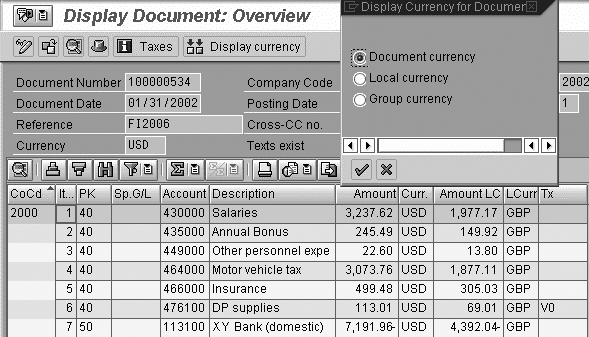
Figure 2
Display currency button allows you to switch currency types in the overview display
Actual selection of currency code for a currency type depends on each specific transaction. See Figure 3 for examples of different transactions and how the currency types map to actual currency codes.
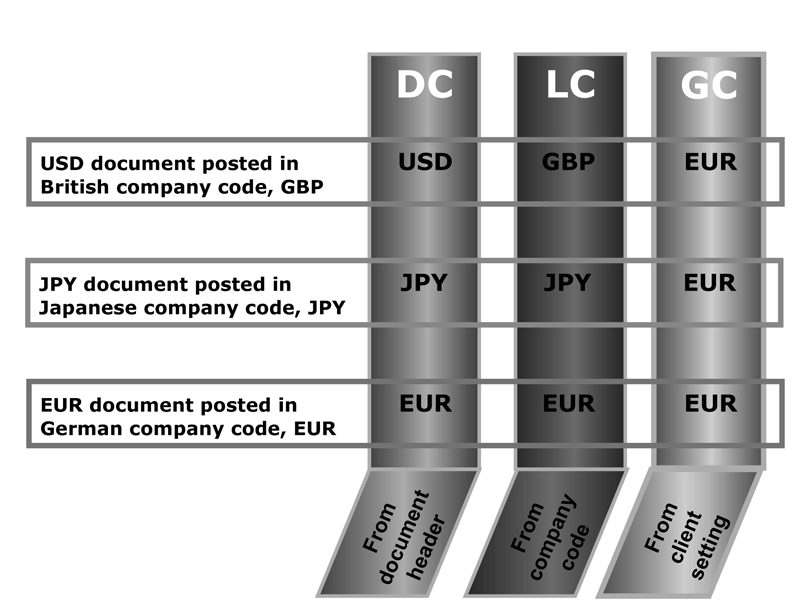
Figure 3
Actual currency code for each currency type depends on the specific transaction
Ledgers
Ideally, all ledgers should use the same currency types to avoid translation and reconciliation issues, as represented in the diagram in Figure 4. However, different ledgers in your system can use different currency types (Figure 5). Historic configuration in your system or special reporting requirements may necessitate it. For example, when you first went live with SAP you did not activate group currency for FI-GL, but you activated group currency for FI-SL later. This is not an ideal situation, as it can lead to translation issues between ledgers, which I will discuss. Also, not all currency types are available when configuring a ledger. For example, you cannot use the CO-PA operating concern currency when configuring EC-PCA.
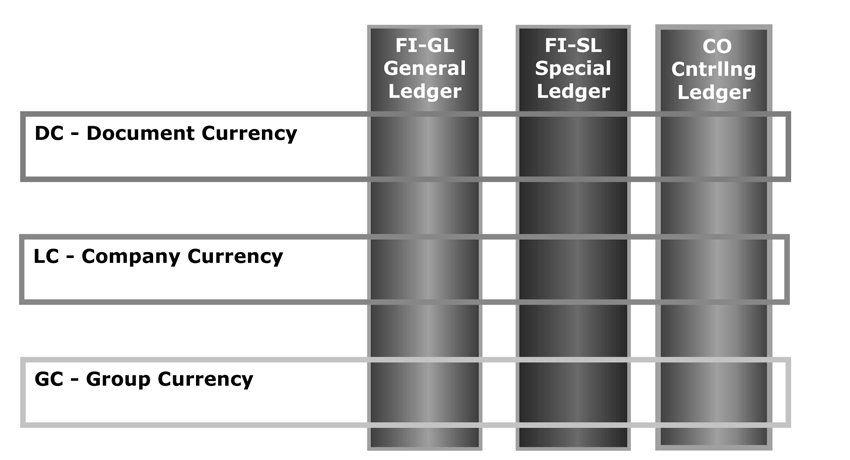
Figure 4
Ideal situation: all ledgers use the same currency types
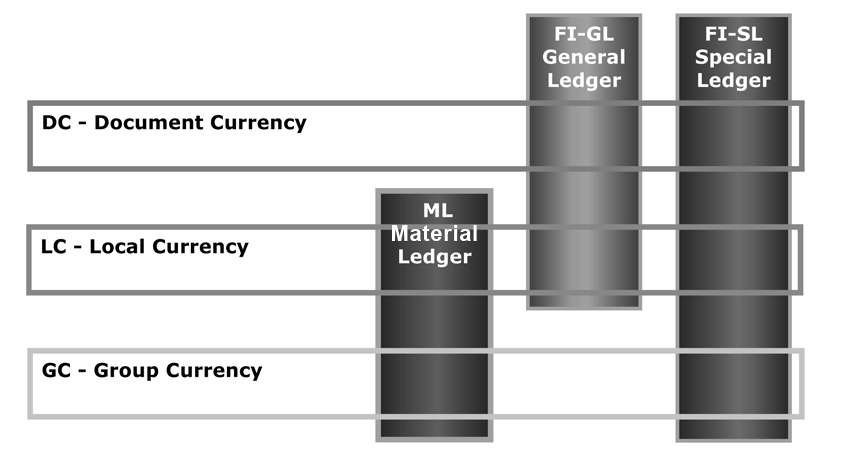
Figure 5
Different currency combinations active in each ledger
Note
Other ledgers (e.g., Profitability Analysis [CO-PA], Enterprise Controlling - Consolidation [EC-CS], EC-PCA, and Material Ledger [ML]), can have currency types configured in similar ways. In most cases the configuration screens for these modules are similar to the FI-SL screen.
Currency Type Configuration
Let’s look at where the currency types are configured for two different ledgers, FI-GL and FI-SL. FI-GL currency types are configured using transaction OB22 (Figure 6). FI-SL currency types are configured once per ledger using transaction GCL1 (Figure 7). Keep the same settings for each company code.

Figure 6
FI-GL currency type configuration screen, transaction OB22
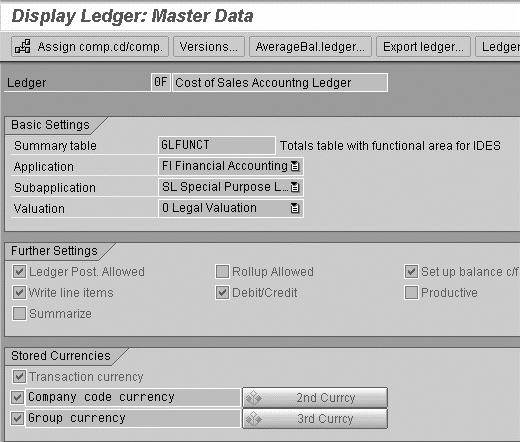
Figure 7
FI-SL currency type configuration screen, transaction GCL1
When choosing currency types for a module, try to choose the common system-wide currency types, DC (00), LC (10), and GC (30). If you choose a module-specific currency type (e.g., (currency [80]) for FI-SL, this gives you the freedom to choose the currency code that maps to the currency type, but potentially causes translation problems when data feeds from FI-GL to other modules. In some cases, such as controlling area currency (20), SAP advises you to use group currency (30) instead. See SAP notes 119428 and 314936.
Sometimes you have no alternative but to choose a module-specific currency to meet your reporting requirements. For example, you have a US-based company, with group currency USD, with multiple companies in Europe. The European region requires consolidated accounts in EUR. To get this reporting you can create a new ledger in FI-SL, EC-PCA, or EC-CS with EUR as a module-specific currency, using currency type 80, 90, or C0 respectively.
Source Currency Type
When configuring the ledger or module, you can specify the method of calculation for the additional currency types (Figure 8). This affects the value of the additional currency posting. When posting an FI-GL document, the user can enter a value in one currency field only (e.g., document currency) and the SAP system automatically populates the other currency fields (such as group currency) using the source currency rules you define. You have the choice of transaction currency or local currency (Figure 9). SAP recommends converting from the first local currency. See SAP note 335608.
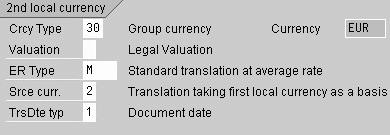
Figure 8
Specify the method of calculation for additional currency types

Figure 9
Source currency type options for translation to additional currencies
The FI-GL module allows you to configure up to four currency types, while most other modules, including FI-SL and EC-PCA, allow up to three for a single ledger. Should you require more than three currency types, you have to configure a parallel ledger in FI-SL. The parallel ledger has exactly the same structure as the first ledger you create, except that it has different currency types configured. This may be required for EC-PCA if you activate one of the additional valuation types and still want to maintain reporting in legal valuation. Remember that EC-PCA is just ledger A8 in FI-SL, so create a custom copy of the A8 ledger, (named, for example, Z8), in FI-SL. Then configure this ledger with the additional currency types and have all the same transactions that post to ledger A8 post to ledger Z8, the new parallel ledger.
Changing Currency Type
Once a ledger is productive and transactions have been posted, adding another currency type or changing a currency type takes a lot of work. For example, say FI-GL was configured initially with DC and LC only, and now you want to add GC. In these cases you must call in the SAP System Landscape Optimization Group to make the change for you (see SAP notes 27621 and 39919). This change is not impossible. For example, during the Euro conversion in 1998-1999, a German company’s currency code would have been changed from DEM to EUR and the LC values of all transactions would have been converted from DEM to EUR. There is one exception for CO (see SAP note 314936).
Currency Type Transactions
This section covers scenarios that highlight the problems of misconfigured currency types for multi-ledger/module SAP Financials environments. First I will show how data posted in sender ledgers FI-GL and CO get to receiver ledgers FI-SL, EC-PCA, EC-CS, and so on. You use the RWIN interface (Figure 10) to post FI data to multiple modules.

Figure 10
RWIN is the interface used to post FI data to multiple modules
With misconfigured ledgers you may run into problems such as a different DC value from GC value even if both are the same currency (Figure 11).

Figure 11
FI-SL document with different USD values in TC and GC
This type of difference can occur when FI-GL is configured with just DC and LC while FI-SL is configured with DC, LC, and GC. When the FI-GL document is posted the user enters both a DC and LC value with a manually calculated exchange rate of 1.70. When the document is posted to FI-SL, the GC value is calculated from the LC value using the M rate, the default rate in SAP, of 1.24. This results in the DC value in USD and GC value in USD being different (Figure 12).
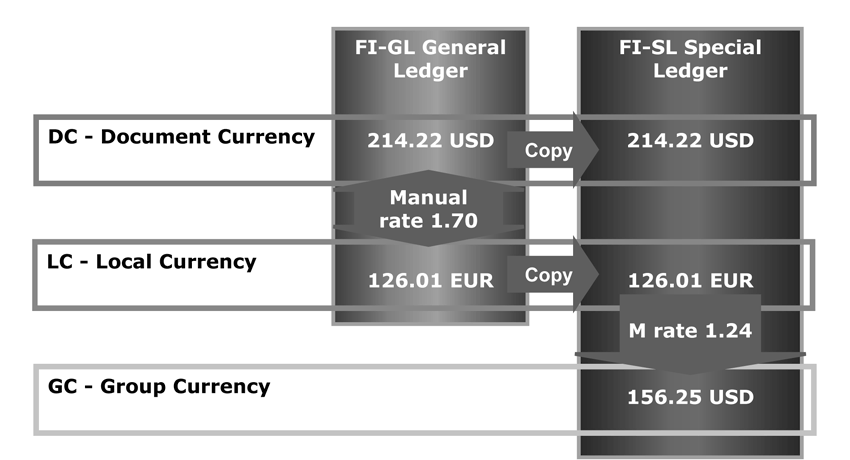
Figure 12
Missing GC in FI-GL leads to inconsistent value in FI-SL
Let’s look at a more dramatic example where the use of ledger currency (80) instead of group currency (30) in FI-SL can cause problems when both map to the same currency, EUR. In this example, transaction FBB1 is used to make a group currency only adjustment entry of EUR 200.00 in FI-GL (Figure 13), which is expected to flow through to FI-SL. In FI-SL, use of ledger currency results in the local currency value 0.00 GBP being converted, resulting in a posting of 0.00 EUR in FI-SL (Figure 14) instead of the expected 200.00 EUR. For more details on this type of problem, see SAP note 142367.
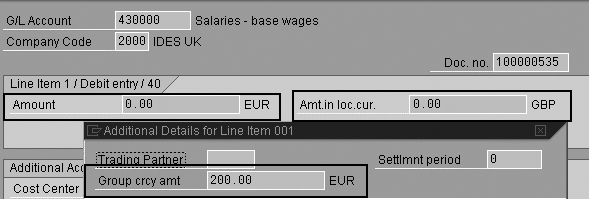
Figure 13
Group currency only FBB1 adjustment entry in FI-GL

Figure 14
How an incorrect value can get posted to FI-SL when ledger currency is used
As mentioned earlier, the specific currency to which a currency type maps varies for each transaction depending on the values entered by the user, such as company code and cost center. To get the specific currency code for a currency type, use function module G_CURRENCY_FROM_CT_GET found in the function test bed of transaction SE37. You need to supply additional transaction data (e.g., company code) to get the specific currency code.
Valuation Types
Supplemental valuation methods are used to store transaction data valuated for transfer pricing, consolidation, and other internal valuations aside from the normal transaction value (Table 2). Create valuation types other than the normal legal valuation (x0) only as part of an integrated scenario, which requires you to define an appropriate currency and valuation profile for the controlling areas affected.
| Valuation code |
Description |
| x0 |
Legal valuation |
| x1 |
Group valuation |
| x2 |
Profit center valuation |
|
| Table 2 |
List of valuation types |
The currency and the valuation method are combined in the financial accounting document to form the currency and valuation type. For example, if you want to make a group valuation in the group currency, SAP uses currency type 31. Only some currency types allow the addition of valuation types.
Configuration
Valuation type is configured in the same transaction as the currency type but in a different field. For FI-GL configuration, use transaction OB22. For FI-SL ledger configuration, use transaction GCL2.
Often multiple valuations are activated after the SAP system has been active for several years. If the controlling area currency is the same as the group currency and material ledger has not yet been used, you can activate multiple valuations in the standard system without having to carry out a conversion (see SAP note 120380 for more details). You need to compare the as-is and to-be environment carefully to determine the level of complexity.
Transfer Pricing
Transfer price is a negotiated price between two organizations belonging to the same group of companies. It may be based on the market price, or it may be determined as a markup on the cost of goods manufactured as seen from the legal valuation. These markups can depend on a number of factors, such as the profit centers involved, the product, plant, date, and so on.
Legal Valuation
Currency types ending with a 0 denote Legal Setting (for example, currency types 10, 30, 40, and 50). This is the standard valuation type and represents normal valuation of business transactions.
Group Valuation
Many groups valuate exchanges of goods between affiliated companies using a group cost of goods manufactured (i.e., without internal profits). The receiver profit center receives a semi-finished product at cost. In this approach, profit centers only earn profits with unaffiliated companies and not for internal transactions.
Used for consolidated reporting where internal profit or mark-up is not included, currency types ending with 1 denote a Group Setting (for example, currency type 31). It uses transfer pricing to monitor internal profit and loss between companies. The ML and CO modules must be active; EC-PCA does not have to be active.
Profit Center Valuation
As of SAP R/3 3.1, you can valuate business transactions in EC-PCA with the same method used for the individual financial statements of the companies in a group. If you use your profit centers to monitor their internal profits, you must activate transfer pricing for exchanges between profit centers. These transfer prices are selected automatically for goods movements (stock transfers, goods usage) between profit centers and are shown as Internal revenue and Internal costs in EC-PCA. Thus a goods withdrawal for a production order is shown as a sale in EC-PCA, whereas the same transaction is a consumption posting when seen from the point of view of the company code.
To activate profit center valuation, the EC-PCA, ML, and CO modules must be active (see SAP note 119773 for an exception). You need to activate special pricing conditions in SD for internal sales. Internal revenue and inventory change journal voucher (JV) lines are added to inventory postings in the profit center valuation view. Once you activate profit center valuation for EC-PCA, legal valuation in EC-PCA is not possible. You may need a shadow PCA ledger (see SAP note 861965).
Inflation Accounting
In the 1970s, in addition to bad haircuts, high inflation rates were all the rage, sometimes in excess of 1,000% a year. When accounting for transactions over one year using a high-inflation currency, the results were highly unreliable. To avoid this type of reporting problem, companies recorded transactions in both the local currency and a hard or more stable currency, often USD.
SAP provides two methods of inflation accounting using currency types, hard currency (40) and index currency (50). A hard currency is assigned to a country code in transaction OY01, table T005. When a transaction is posted, the system selects the hard currency based on the country key of the company code.
The same system works for the index currency method. Rather than a hard currency, inflation is calculated using an index currency, which is a fictitious currency stipulated for external reporting (such as tax returns) in some countries with high inflation.

Rohana Gunawardena
Rohana Gunawardena heads the SAP practice division at Exium Inc. Exium is a leading business and technology consulting firm that enables companies to achieve their strategic business goals. Exium specializes in delivering superior IT solutions using ERP systems, with a special focus on SAP products. Rohana has been working with SAP since 1992. During his career he has assisted multiple clients on detailed system correction projects, such as correcting inventory balances, controlling area reorganizations, retrospectively activating group currency, and optimizing inter-company accounting transactions. He has spoken at many SAP conferences and has published more than 20 articles in Financials Expert, SCM Expert, and SAPtips on various aspects of SAP. His presentations have focused on Financials module selection, the order-to-cash process, global rollouts, business segment reporting, cross-module integration, and the financial impact of SCM transactions. Rohana is widely acknowledged as a leading SAP expert. Rohana is a Fellow of the Institute of Chartered Accountants in England & Wales. Previously Rohana has worked with the consulting practices of Accenture, Deloitte, and PwC.
Rohana will be presenting at the upcoming SAPinsider Financials 2018 conference October 16-18 in Prague. For information on the event, click
here.
You may contact the author at Rohana@Exium.com .
If you have comments about this article or publication, or would like to submit an article idea, please contact the editor.



















